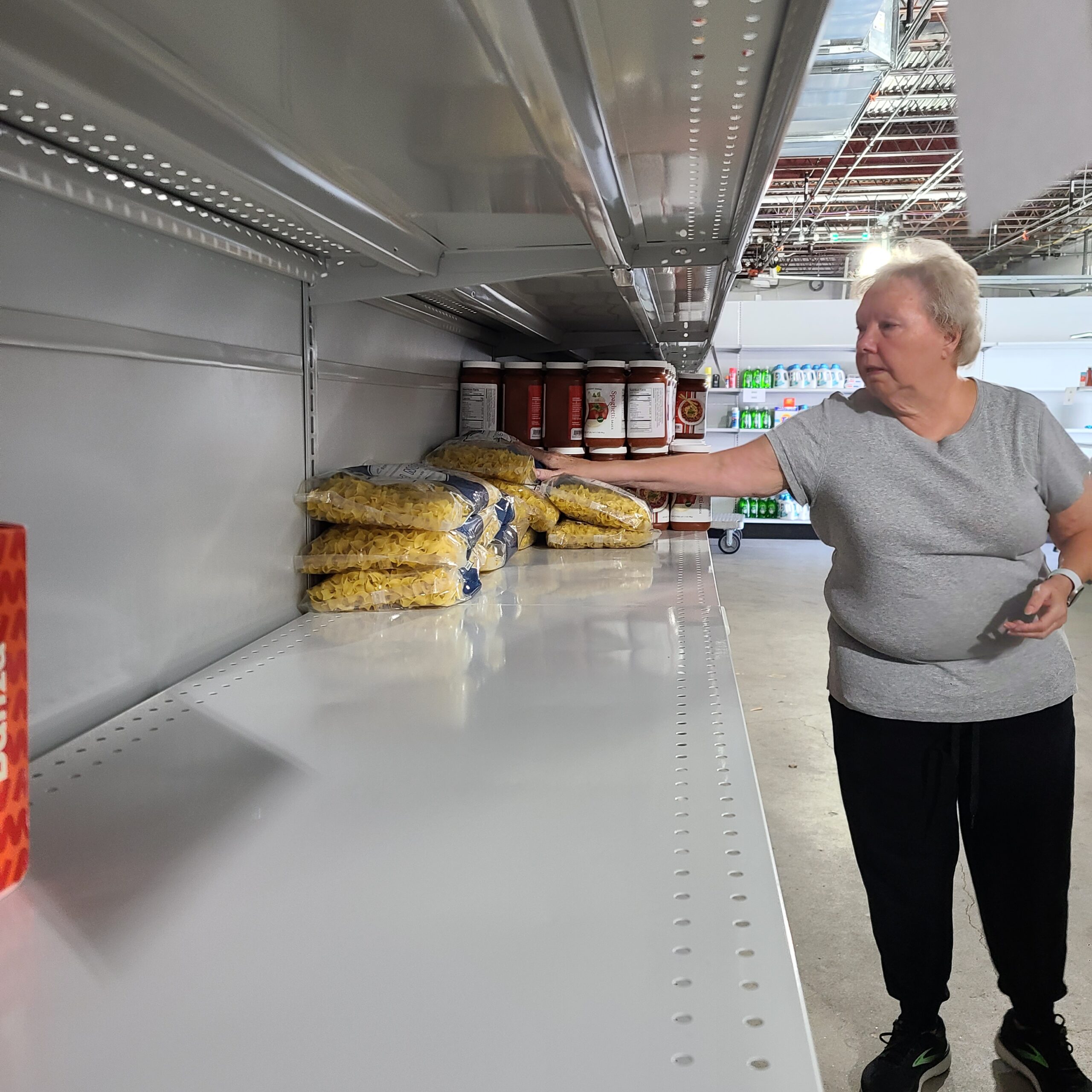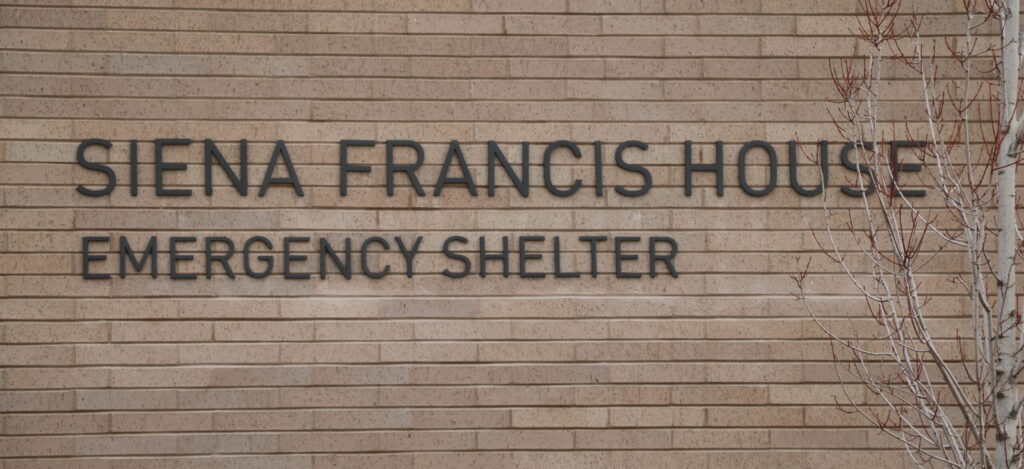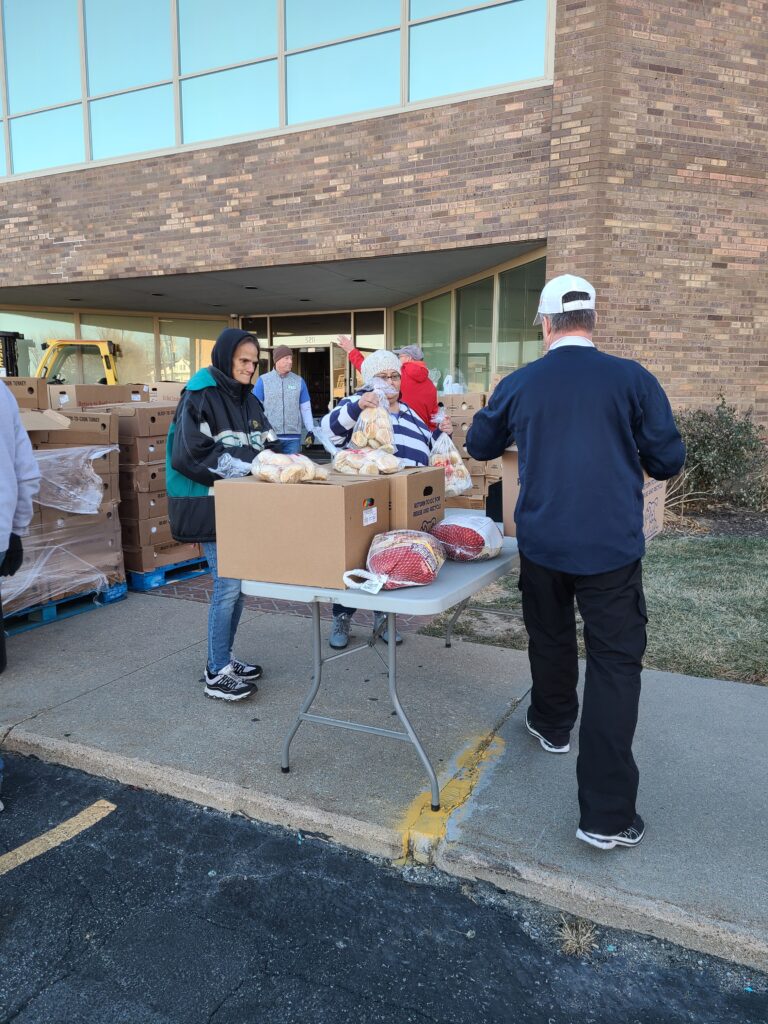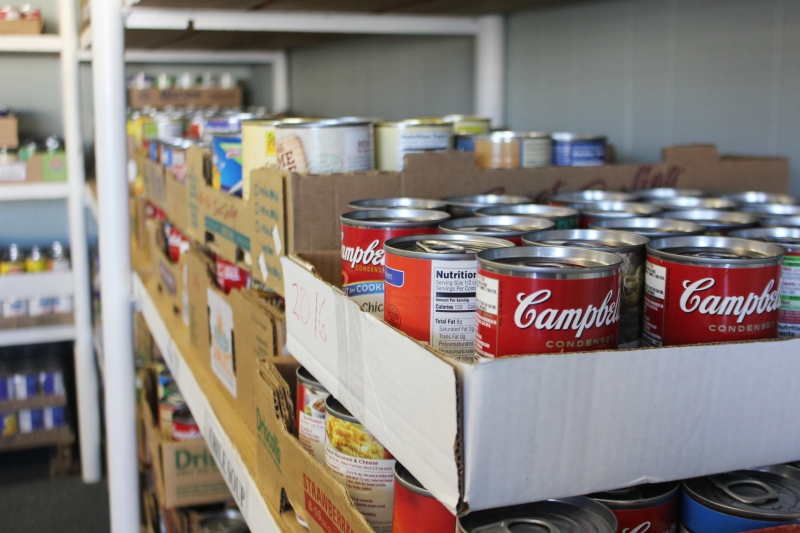
A volunteer helps stock shelves at a Catholic Charities of Omaha food pantry. COURTESY PHOTO
Living Mercy
Homeless shelters, other organizations work on ways to tackle growing needs
November 21, 2023
Signs of growing poverty and need have become more apparent in the Omaha area: full or nearly full homeless shelters, more homeless encampments, panhandlers at many intersections and increasing numbers of people needing help from food pantries.
The signs also are showing up elsewhere in the archdiocese. In the Columbus area inflation is pinching budgets, slowing donations to charities and making owning a home more out of reach.
Jobs seem to be available, but new refugees in the Columbus area have to wait to get the required government documents to fill them. Meanwhile, multiple immigrant families fill single-family dwellings.
With the growing needs and winter cold creeping in, local aid organizations are adapting and figuring out new ways to help.
On a recent warm November day, five of the six homeless shelters in the Omaha-Council Bluffs metropolitan area had no available beds.
Only the Siena Francis House in Omaha had room for someone needing a place to sleep: five beds for women and 82 beds for men.
No beds in the metro area were available for families in need of emergency overnight shelter.
“I mean, it’s beautiful out,” said Michael Wehling, chief executive officer of Stephen Center homeless shelter in Omaha. “It’s 70 degrees today and our shelters are full. The fear that we have … is what are we going to do when it gets cold? … What do you do when it gets down to zero and everybody comes in?”
“Even our veterans, who are the most capable people out there, even they’ll come in when it gets really cold,” Wehling said.
“We have to have room” for all the homeless in the community, he said.
Siena Francis House in Omaha also was filling up while the weather was still warm.
“A month ago, we would’ve had a hundred or 125 beds available every night,” said Linda Twomey, executive director and chief executive officer at Siena Francis House homeless shelter in Omaha.
The number of available beds fell off in recent days, to less than 75.

With colder weather, “we think that trend is really going to continue,” Twomey said. “We do not have any shelter beds available for women,” she said. “Our women’s beds are continually full. And then our men’s shelter beds, there’s been a very large increase in just the last few weeks.”
Siena Francis House, which serves about 3,000 people annually through its programs, has 100 shelter beds for women and 360 beds for men. The amount of beds corresponds with local and national needs that show men experiencing homelessness at higher rates than women.
Typically in cold weather, the shelters squeeze people into any available space.
“Here at the Stephen Center,” Wehling said, “we’re able to go into overflow … but of course that takes a lot more resources: additional staff, additional costs.”
But “we’re fortunate to be in Omaha,” he said, “where we have a lot of different organizations so that we can all lean on each other and hopefully keep everybody safe and secure.”
STEPPING UP
Other organizations – which help with food, rent, utility bills, mental health counseling and other services – also are seeing increased needs.
The Society of St. Vincent de Paul Omaha – which in its last fiscal year distributed about 625,000 pounds of food to 22,801 individuals through its food pantry services – has been giving away more with fewer resources.
“What we are seeing,” said Jill Lynch-Sosa, executive director, “are longer lines, fewer donations from all sources, and now more ‘working poor,’ or those whose incomes haven’t kept up with inflation and now need a little assistance to supplement their family groceries.”
Donations for St. Vincent de Paul’s lunch sack program also have decreased, Lynch-Sosa said. “It’s just a difficult time for everyone, and many of the peer pantry and lunch programs have told us they are also experiencing the same challenges.
“Omaha has many generous people,” she said, “and we just pray they will continue to come through for our neighbors in need as they always have in the past.”
Catholic Charities of Omaha also has experienced a steady, steep rise in need.
In 2019 the organization distributed 200,000 pounds of food to about 80,000 people. In 2022 Catholic Charities gave out more than 2 million pounds of food to more than 300,000 people.
Those statistics just keep rising and need to at least stabilize, said Dave Vankat, chief community engagement officer for Catholic Charities.
“We can’t sustain that level of increase year over year,” he said. “So we’re trying to now bring it back to where it’s more manageable and limit how often we are distributing food to people.”
“We’re trying to give them more, less often,” Vankat said, to help shorten lines.

Food is being distributed outside Catholic Charities’ Juan Diego Center. COURTESY PHOTO
Catholic Charities also is seeing more people needing help for mental health issues and addictions.
“We’ve got 10 therapists – some of those are in our school program – but we probably could hire another six, seven or more and still not be at the capacity for all the needs,” Vankat said.
NEEDS IN COLUMBUS
Inflation and a housing shortage are burdening people in the Columbus area, said Bonnie McPhillips, director of the Columbus Housing Authority. She also serves on the board of directors for Simon House, a charity run by the St. Vincent de Paul Society conferences of Columbus’ three Catholic parishes.
“It’s just tough for everybody, even if you’re working,” McPhillips said, “just because of what gas and food costs.
“We’re seeing more people ‘house-burdened,’” she said, spending more than 30% of their income on rent, as rent and utilities continue to climb.
“Even if you own a home,” McPhillips said, “our taxes have gone up tremendously.”
“I’m on the housing committee for the Chamber here, and the bankers tell us that just between tax increases and the insurance increases on your home, the mortgage to meet your escrow is going to go up three to four hundred (dollars) a month.
“So they’re very concerned that there’s going to be families that won’t be able to make their mortgage payments. It’s a challenge.”
Columbus has a large shelter that recently added space, “and it stays pretty full,” McPhillips said.
Community members are working on establishing a homeless shelter for families. “We really don’t have that here,” she said. “Our homeless shelter is mainly for single individuals.
“So it’s been a challenge,” McPhillips said. “We have some United Way money that is helping us get started” on the family shelter, “and then we are basically working with landlords to house people and give them six, eight months to get on their feet.”
At Simon House, “we put people up in hotels – and whatever we have to do. Especially if it’s anybody who has children, we’re going to do whatever we can to help them.”
“We need transitional housing for families here so bad,” she said.
A recent influx of immigrants to the Columbus area, many from Cuba, are struggling.
Many of the asylum-seekers don’t have the needed documents yet to get jobs and federal assistance, McPhillips said, while other agencies and organizations have waiting lists for help.
“I don’t know where they’re living,” she said. “I’m just hearing in the community that there’s many households that have three and four families staying together.”
“We have plenty of jobs here,” she said. “I mean, the economy’s been pretty brisk here. We’re very fortunate for that. So they come here for jobs, many of them will tell you that. … Hopefully Immigration is working on getting them refugee status so they have a document to get a job legally.”
In the meantime, Simon House has been helping the immigrants with food, household items and clothing.

Simon House food pantry. COURTESY PHOTO
COUNTING THE HOMELESS
In the Omaha-Council Bluffs area, the Metro Area Continuum of Care for Homeless (MAACH) helps unite the efforts of shelters, housing organizations, support services and faith-based groups in helping those in need.
The organization also tries to track the number of homeless.
Shelter numbers dwindled during the pandemic and have since risen to close to pre-pandemic populations, according to January counts conducted by MACCH. Those point-in-time counts help point out trends and are mandated by the federal government.
Also counted were the number of homeless not living in shelters. That number rose more dramatically, especially in the last two years, from 46 people counted in January 2019 to 205 people in January 2023.
Omaha Metro Homeless Population by Susan Szalewski
“So we are seeing an increase of street homelessness,” said Jason Feldhaus, MACCH’s executive director.
More people are living outside, beginning with the COVID-19 pandemic when people were afraid to come inside shelters, Twomey said. Also, city policies on how homeless encampments are managed seem to have changed, with fewer orders to vacate.
“We have seen an increase in unsheltered homeless people living outside or in places not meant for habitation,” Twomey said, and shelters have been responding to that shift.
In 2021 Siena Francis House started a street outreach team, which served 112 people that year. In 2022, the team helped significantly more, 217 people.
“I think this year we’re probably projected to serve as many, if not more,” she said.
Outreach teams at Siena Francis, Stephen Center and elsewhere offer help and support, including food, coats, blankets, sleeping bags – “whatever will help,” Wehling said.
The teams also can offer an immediate place to stay or help with a more permanent housing situation, such as moving back in with family, getting treatment or staying at a halfway house.
“The whole goal is hopefully for them to end up feeling as though they can trust and come into the facilities, utilizing warming centers if they’re willing to,” said Beth Robbins Ellis, community engagement director at Stephen Center.
Many of the people who work on the Stephen Center outreach team have been homeless themselves, Wehling said, and understand some of what those living on the streets are going through.
CHRONIC HOMELESSNESS
Also rising, Feldhaus said, is “chronic homelessness,” defined by the federal government as living in a place not meant for human habitation or in a safe-haven emergency shelter for 12 continuous months, or during four times in the last three years, for a total of at least 12 months.
“So basically a third of the time, over three years, you’re homeless,” Feldhaus said. “We’ve seen an increase from about 25% chronic homelessness to about 33 to 35% now,” he said.
This year about 40% of the people served at Siena Francis House fit the definition of chronically homeless.
“Chronically homeless people are harder to get back into housing,” Twomey said. “They typically have more barriers to housing, like bad credit, criminal histories, evictions in their past.”
“Just two years ago, the percentage of chronically homeless that we were seeing was 26%,” she said, and that rise of 14 percentage points “has had a big impact on us.”
The chronically homeless tend to stay longer at the shelter, Twomey said, and helping them with their needs is more complex and demanding.
The chronically homeless are part of the reason for the rise in people living on the street.
“They’ve already gone to shelters multiple times and have just decided that they don’t want to be there anymore,” Feldhaus said. “And we can’t commit anybody or force anybody in shelters or anything like that. They have domain and dignity of their own choice.
“We may have beds available at times,” he said, “but you’ll see them on the street because the individuals choose that option.”
Siena Francis House offers 98 homes for people who are chronically homeless and have disabilities. “Most of them have a serious, persistent mental illness,” Twomey said. “They lease, and we provide them with wraparound supportive services in terms of case management, transportation and other things they need to stay stably housed.”
Although many people are chronically homeless, a growing number are also new to homelessness.
In 2022, of the approximately 5,800 homeless people in the Omaha area, more than 3,500 became homeless for the first time, Twomey said. That’s an increase of more than 500 people from the previous year, she said.
FAMILIES AND SENIORS
While the number of homeless veterans has been decreasing both nationally and locally, homelessness for other segments of the population is increasing.
“There used to be a lot of young families or young individuals who hit some bumps in the road, or they just needed a job,” said Wehling, of Stephen Center. “Now we have individuals who are older,” who have disabilities.
“I think people think of homeless people as being very young,” Twomey said. At least 60% of the people served at Siena Francis House are 50 and older, she said.
Often they’ve become unable to work because of a physical disability, an active addiction or a mental health issue.
Younger people tend to still have the support of parents, roommates or a network of people, Twomey said. “Then at some point in life that kind of stops, that kind of support. Then those people who are struggling, they don’t have that support anymore, and they enter homelessness.”
Rent has risen at least 8.8% in the Omaha area, Feldhaus said. Some say as high as 28%. That’s especially concerning for seniors on fixed incomes who are also dealing with rising consumer costs at a rate of about 7.5%, he said.
PANHANDLERS
In most cases the people who beg for donations on street corners are housed, Feldhaus said. “They have a home somewhere. Our street outreach team makes contact with them. But they’re on a fixed income, whether it’s disability or Social Security or whatever, it no longer meets the inflationary need that they have. So they’re out trying to gather other additional income.”
It’s OK to be skeptical of the panhandlers, said Teri Corcoran, chief development officer at Stephen Center. She recommended giving gift cards instead of cash. She suggests calling a nonemergency police number for a well-being check if children are out in dangerous weather.
SOLUTIONS
The Stephen Center is working on “shared housing,” pairing up compatible homeless people, mostly those on fixed incomes, to live together affordably, Robbins said. “We’re at the beginning stages of that right now, and we’re really hopeful that perhaps this can help.”
People don’t want to live alone, Wehling said. “I know that at least here at the Stephen Center, one of the reasons people don’t want to leave is because of the sense of community, the relationships that they’ve built and the fact that they feel safe and secure in an environment with all of us, and you just don’t want to move back out by yourself.”
Being alone isn’t good, particularly if a person has suffered from substance abuse or mental illness, he said.
“I think being human and being by yourself is not good for anybody.”
Feldhaus said homeless and poverty can seem like overwhelming problems, “but I will say that there’s some good things happening, too.
“I think we have great providers in the community that work really hard every day to find individuals permanent housing.
The City of Omaha – including the mayor’s office and police department – have been active trying to find strategies to address homelessness, he said.
The Sarpy County Sheriff’s Office and Council Bluffs police have officials trained in mental health who help work with people experiencing homelessness, Feldhaus said.
Redevelopment plans in north and south Omaha include affordable housing.
“There’s a lot of good things that are happening,” he said. “We’re at a point of high needs and a lack of places to put people, but I do believe that the community will be building options as we move forward. And the more options we have to put people in, the greater likelihood that homelessness will reduce.”
READ MORE FROM THE CATHOLIC VOICE